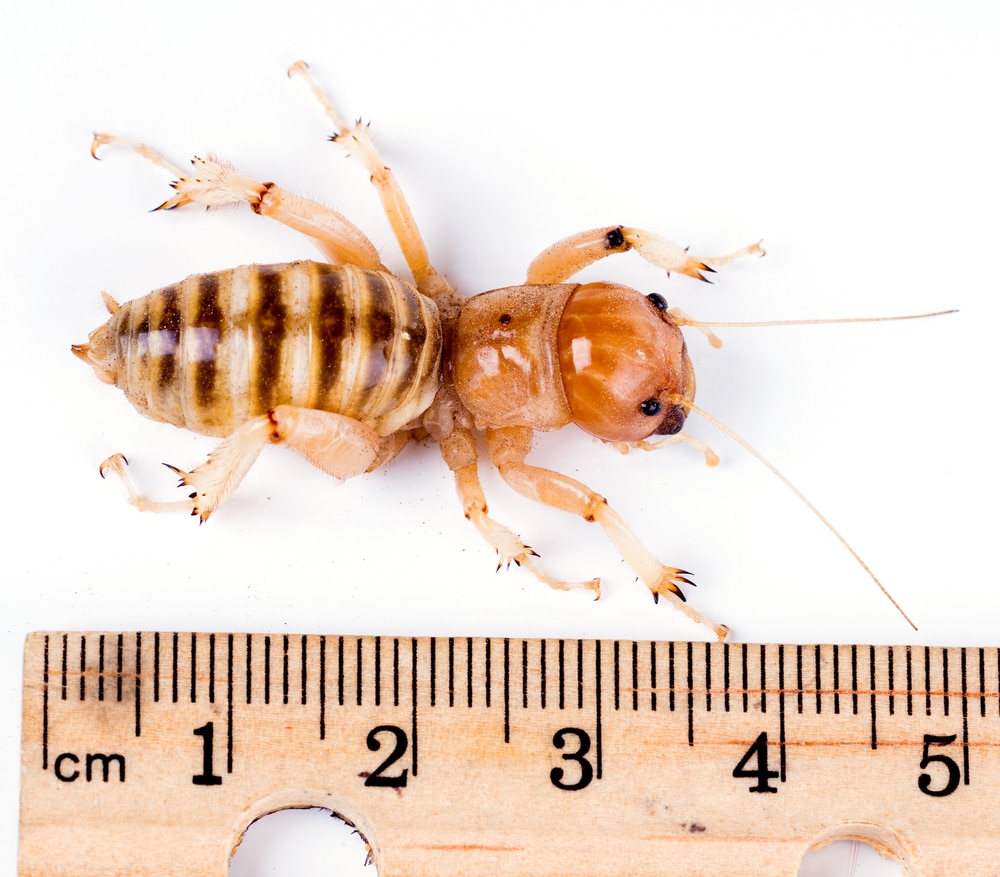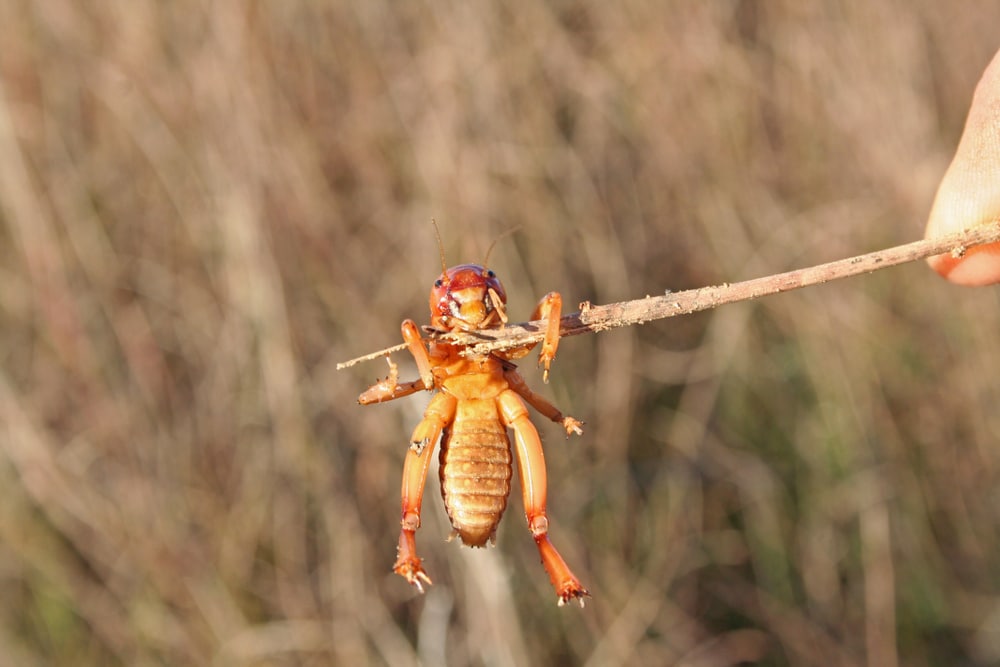The Potato Bug (Stonopelmatus fuscus), or the Jerusalem cricket, is a species of insect related to grasshoppers and crickets. Known as Who-tzi-Neh or the old bald-headed Man, by indigenous cultures, the potato bug has many names for its awkward and unique appearance.
They share their common name with many different types of insects. Leading the way to confusing accusations of a misunderstood creature. Potato Bugs are often confused with the potato beetle, a pest that is highly detrimental to agriculture. The potato bug, however, is the innocent – yet unappealing – underdog. For clarity, this article is about the potato bug not the potato beetle.
In this article, we’ll explore all about the potato bug, their often confused nemesis: the potato beetle and also the pill bug, and how they are highly beneficial within their ecosystem, aiding in decomposition and playing a key role in the nutrient cycle.
Now, will the real potato bug, please stand up?
What Are Potato Bugs?
These bugs are related to grasshoppers and crickets. They are omnivores, eating mostly plant matter, but occasionally they’ll eat insects and carrion. They have powerful, sharp jaws, and bite if handled irresponsibly. Their pinch may hurt, but they are all bite and no bark as they are not poisonous or venomous in any way.
Generally, a solitary insect, the potato bug lives a fossorial existence. This means it spends the majority of its life underground. The best time to observe is in spring, as they come up to the surface to mate. They are nocturnal and spend the majority of their time foraging at nighttime for their food source.
They are native to the South Western United States. But you can find them all along the West Coast of the United States, up to Canada, and as far south as Mexico and Central America.
Identification Of Potato Bugs

They are one weird-looking bug! This potato has a large, stout body clad in armor with a round, shiny bald head.. This bug can grow to go over 3 inches (8 centimeters) in length.
Their antennae are located beneath black beady eyes that are set far apart. These insects are wingless, spending all of their time on or in the ground. They have thick, strong legs that are barbed with spines used for digging.
They look like a mix between a cricket and a millipede!
“Types” Of Potato Bugs

These bugs are often confused with other insects like potato beetles and pill bugs. These guys get a bad rap because of a similar common name. This is the number one reason why Latin names are so important. All three of these insects are unrelated, one is not even an insect! Let’s go over their differences, what roles they play within their environment, and which one you should be keeping your eye out for in the garden.
What Are Potato Bugs?
- They are in the grasshopper family
- They are decomposers in their ecosystem
- They are not a pest in the garden
- They are a gardeners ally
What Are Potato Beetles?
- Potato beetles are in the beetle family
- Another name for them is the Colorado potato beetle
- They are a major garden pest. The potato beetle can be detrimental to your garden and to crops, like potatoes, carrots, and eggplants
- The potato beetle is a prey species within its ecosystem
Best Practices For Managing Potato Beetles In The Garden
For effective control methods for managing the potato beetle in your garden, it is important to note that this insect easily becomes resistant to chemical sprays and pesticides. More sustainable methods of removal are advantageous for this creature.
Try removal methods like:
- Standing Stubble: Leave grass or crop roots after harvesting. This acts as a deterrent and will attract the potato beetle away from prized crops
- Crop Rotation: Rotate crops seasonally to reduce the spread of this bug
- Biological Mitigation: Add ducks and chickens to your garden, they love to snack on beetles!
What Are Pill Bugs?
- Pill bugs are an isopod, a non-insect arthropod
- Pill bugs are land-based crustaceans
- Pill bugs are related to crayfish and lobsters
- Pill bugs do not bite or are harmful in any way
- They have armor-like shells that protect them from predators
- They roll into a ball as a defense mechanism
- They decompose organic matter in their ecosystem
Potato Bug Life Cycle

Now back to the potato bug! Their life cycle is considered an incomplete metamorphosis. It is split into three segments: egg, nymph and adult. The beginning of their life cycle is slow, they spend between 2-5 years becoming a full-fledged adult.
Egg
Small masses of eggs are laid in the soil. These eggs are small 0.1 inch (3 mm) and oval-shaped. They resemble a tiny bird’s nest, deposited under the ground.
Nymph
Eggs hatch into the nymph stage. These bugs stay underground and begin to eat. They will molt multiple times during this stage, and they reach adulthood after 1.5 years or more, depending on the species.
Adult
It takes approximately 1.5 years for a potato bug to reach sexual maturity. They live for 2- 6 months as adults, mating and depositing eggs during this time.
Mating season includes a drumming beat that both males and females take part in. They do this by beating their shelled abdomens on the ground to create a drumming sound. In general, this beat cannot be heard by humans, but some species of potato bugs produce drumming so loud that it is audible through the soil!
Where Do Potato Bugs Live?

Natural Habitat
Potato bugs are native to the Southwest of North America. They can be found as far north as southern British Columbia, Canada and as far south as Mexico and Central America. In between they are found in the midwest to west coast, encompassing a wide distribution including Colorado, Dakotas, Kansas, Texas, Oklahoma, and Nebraska.
With this range, These bugs main habitats are found in:
- Woodland ecosystems
- Grasslands
- Deserts
They spend most of their time underground and prefer sandy, loam soils to clay. They are attracted to moisture, so be sure to check under rocks and decomposing logs.
Potato Bugs And Their Diet

What Do Potato Bugs Eat?
The potato bug spends its time feeding under the earth’s surface. Their main diet includes roots, tubers, and decaying organic matter.
They are nocturnal and will come above ground at night to eat insects, carrion, and other plant debris. It is more common for them to come above ground after it has rained.
In the garden, They eat the tubers of dahlias, potatoes, and carrots. It’s important to note that they are not detrimental to crops but may nibble on tubers and other root vegetables.
Potato Bugs In Houses And Gardens
These bugs have been found living year-round in people’s homes. They are drawn to moisture and damp environments. If you have these bugs in your home, this can be an indicator that there may be damp areas in your house.
Benefits Of Potato Bugs In The Garden
These bugs play many beneficial roles in their ecosystems. They are a high-protein food source for many animals higher up on the food chain. Most importantly, they play a role in nutrient cycling. They aid in the decomposition process by eating decaying plant and animal matter. They help to create healthy, productive soils.
Are Potato Bugs Harmful To Plants?
They are not harmful to plants. Potato bugs have several other food sources and do not rely solely on root vegetables for sustenance. They are also solitary, meaning you won’t find large numbers of them congregated in your garden. Their role in nutrient cycling and the aeration of soils is a positive contribution to soil health.
Sustainable Methods To Get Rid Of Potato Bugs

If you notice these bugs in your garden or home and want to mitigate against them, here are some ways to do so:
- The best way is to remove moisture from your house or garden. Add a dehumidifier, and seal up any cracks in your home.
- Clean up all debris from your garden. It’s important to remember, that if you are removing debris from your garden, you may be mitigating the potato bug, but you are also removing important habitat for other beneficial bugs like pollinators.

